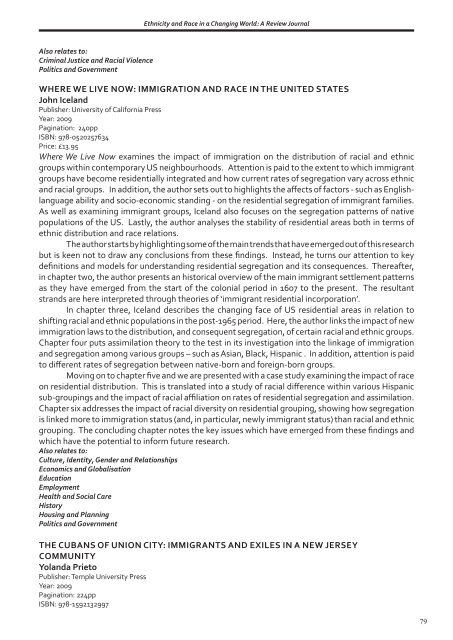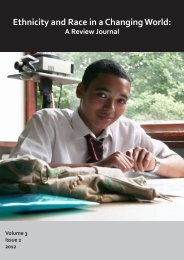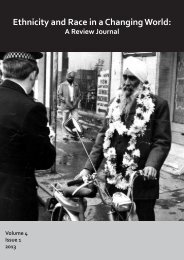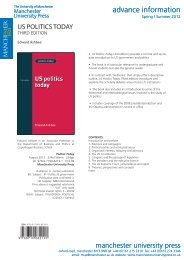<strong>Ethnicity</strong> <strong>and</strong> <strong>Race</strong> <strong>in</strong> a Chang<strong>in</strong>g <strong>World</strong>: A Review Journalattitude that Brita<strong>in</strong> has of its role <strong>in</strong> <strong>World</strong> War II when <strong>in</strong> reality Jews were largely not welcomed, thehostile environment <strong>and</strong> formation of several anti-Semitic groups <strong>in</strong> response to the refugees is alsooutl<strong>in</strong>ed.Chapter Three looks at post <strong>World</strong> War II refuge, focus<strong>in</strong>g on stories of refugees from Ug<strong>and</strong>anAsians, Somalis <strong>and</strong> Roma communities <strong>in</strong> their own words. The chapter <strong>in</strong>corporates much contextualdetail <strong>and</strong> also looks briefly at Polish, Hungarian, Chilean <strong>and</strong> Afghan refugees.Chapter Four outl<strong>in</strong>es the legal specificities of claim<strong>in</strong>g asylum <strong>in</strong> the UK, look<strong>in</strong>g at the UNRefugee Convention, UK <strong>and</strong> EU law. Chapter Five centres on an analysis of the British system thataims to deter refugees from try<strong>in</strong>g to claim asylum <strong>in</strong> the country. The discussion considers how thissystem, rather than directly contraven<strong>in</strong>g the Geneva convention, subverts its <strong>in</strong>tention throughexcessive bureaucracy <strong>and</strong> penalis<strong>in</strong>g refugees. The chapter exam<strong>in</strong>es categories of status, detention,lack of access to support services <strong>and</strong> forced removal.Chapter Six is made up of several case studies of children seek<strong>in</strong>g asylum analys<strong>in</strong>g how, <strong>in</strong> theprocess of seek<strong>in</strong>g asylum they are not entitled to services they would be if granted citizenship. Thechapter considers education, detention <strong>and</strong> the specific situation of unaccompanied children.Chapter Seven looks at the public imag<strong>in</strong>ation <strong>and</strong> anti-immigration sentiment <strong>in</strong> the popular press.It proceeds to look at the effect of media representations on public op<strong>in</strong>ion <strong>and</strong> f<strong>in</strong>ally looks at theeffects of this on refugees <strong>and</strong> asylum seekers themselves.The conclusion engages with anti-asylum rhetoric as a coded <strong>and</strong> acceptable from of racism,urg<strong>in</strong>g for the need for the UK government to revisit the UN Refugee Convention <strong>and</strong> <strong>in</strong>corporate iteffectively <strong>and</strong> with compassion.IMMIGRATION POLICY AND SECURITY: US, EUROPE, AND COMMONWEALTHPERSPECTIVESEd. Terri Givens, Gary Freeman <strong>and</strong> David LealPublisher: RoutledgeYear: 2009Pag<strong>in</strong>ation: 232ppISBN: 978-0415990837Price: £21.99Exam<strong>in</strong>es the impact of national security concerns on immigration policies <strong>in</strong> Europe, the US, <strong>and</strong> theCommonwealth <strong>in</strong> a post-9/11 climate. L<strong>in</strong>ked to this is an <strong>in</strong>-depth study of the impact of migrationon national policies, <strong>and</strong> whether immigration poses a risk to national security.The <strong>in</strong>troductory essay explores the impact of terrorism on attitudes towards immigration<strong>and</strong> on <strong>in</strong>ternational policies of immigration. It starts by measur<strong>in</strong>g the impact of the terrorist attackson London <strong>and</strong> Madrid on both national security <strong>and</strong> military conflicts worldwide. This is followedby a summary description of the resultant policies which have been brought about <strong>in</strong> a bid to tightenborder controls <strong>and</strong> encourage police aggressiveness.Part one focuses on the national <strong>in</strong>terests <strong>and</strong> immigration policies of the US, both <strong>in</strong> termsof historical evidence <strong>and</strong> contemporary debate. It is comprised of various case studies explor<strong>in</strong>gthe impact of US immigration policy on Lat<strong>in</strong>o communities <strong>and</strong> Muslim communities, as well as anexam<strong>in</strong>ation of un<strong>in</strong>tended consequences of National Security Strategies on graduate placements.In part two, Europe is put under the microscope. The first essay <strong>in</strong> this section challengesthe l<strong>in</strong>kage of terrorism with migration to <strong>in</strong>stead argue that national security controls are largelyunaffected by the prevail<strong>in</strong>g anti-terrorism agenda. In contrast, the next essay highlights thedramatic affect anti-terrorist measures have had on immigration policies <strong>in</strong> contemporary Brita<strong>in</strong>.This is followed by a comparison of pre <strong>and</strong> post-September 11 Europe <strong>and</strong>, exp<strong>and</strong><strong>in</strong>g discussionwith an exploration of the effects of 9/11 on EU immigration policies. The rema<strong>in</strong><strong>in</strong>g essays <strong>in</strong> thesecond section exam<strong>in</strong>e issues of cooperation <strong>and</strong> surveillance, <strong>and</strong> collectivity <strong>in</strong> the twenty-firstcentury <strong>and</strong> beyond.Part three exam<strong>in</strong>es the impact of immigration <strong>and</strong> anti-terrorism policies on former BritishCommonwealth countries – Canada, Australia <strong>and</strong> New Zeal<strong>and</strong>.78
<strong>Ethnicity</strong> <strong>and</strong> <strong>Race</strong> <strong>in</strong> a Chang<strong>in</strong>g <strong>World</strong>: A Review JournalAlso relates to:Crim<strong>in</strong>al Justice <strong>and</strong> Racial ViolencePolitics <strong>and</strong> GovernmentWHERE WE LIVE NOW: IMMIGRATION AND RACE IN THE UNITED STATESJohn Icel<strong>and</strong>Publisher: University of California PressYear: 2009Pag<strong>in</strong>ation: 240ppISBN: 978-0520257634Price: £13.95Where We Live Now exam<strong>in</strong>es the impact of immigration on the distribution of racial <strong>and</strong> ethnicgroups with<strong>in</strong> contemporary US neighbourhoods. Attention is paid to the extent to which immigrantgroups have become residentially <strong>in</strong>tegrated <strong>and</strong> how current rates of segregation vary across ethnic<strong>and</strong> racial groups. In addition, the author sets out to highlights the affects of factors - such as Englishlanguageability <strong>and</strong> socio-economic st<strong>and</strong><strong>in</strong>g - on the residential segregation of immigrant families.As well as exam<strong>in</strong><strong>in</strong>g immigrant groups, Icel<strong>and</strong> also focuses on the segregation patterns of nativepopulations of the US. Lastly, the author analyses the stability of residential areas both <strong>in</strong> terms ofethnic distribution <strong>and</strong> race relations.The author starts by highlight<strong>in</strong>g some of the ma<strong>in</strong> trends that have emerged out of this researchbut is keen not to draw any conclusions from these f<strong>in</strong>d<strong>in</strong>gs. Instead, he turns our attention to keydef<strong>in</strong>itions <strong>and</strong> models for underst<strong>and</strong><strong>in</strong>g residential segregation <strong>and</strong> its consequences. Thereafter,<strong>in</strong> chapter two, the author presents an historical overview of the ma<strong>in</strong> immigrant settlement patternsas they have emerged from the start of the colonial period <strong>in</strong> 1607 to the present. The resultantstr<strong>and</strong>s are here <strong>in</strong>terpreted through theories of ‘immigrant residential <strong>in</strong>corporation’.In chapter three, Icel<strong>and</strong> describes the chang<strong>in</strong>g face of US residential areas <strong>in</strong> relation toshift<strong>in</strong>g racial <strong>and</strong> ethnic populations <strong>in</strong> the post-1965 period. Here, the author l<strong>in</strong>ks the impact of newimmigration laws to the distribution, <strong>and</strong> consequent segregation, of certa<strong>in</strong> racial <strong>and</strong> ethnic groups.Chapter four puts assimilation theory to the test <strong>in</strong> its <strong>in</strong>vestigation <strong>in</strong>to the l<strong>in</strong>kage of immigration<strong>and</strong> segregation among various groups – such as Asian, Black, Hispanic . In addition, attention is paidto different rates of segregation between native-born <strong>and</strong> foreign-born groups.Mov<strong>in</strong>g on to chapter five <strong>and</strong> we are presented with a case study exam<strong>in</strong><strong>in</strong>g the impact of raceon residential distribution. This is translated <strong>in</strong>to a study of racial difference with<strong>in</strong> various Hispanicsub-group<strong>in</strong>gs <strong>and</strong> the impact of racial affiliation on rates of residential segregation <strong>and</strong> assimilation.Chapter six addresses the impact of racial diversity on residential group<strong>in</strong>g, show<strong>in</strong>g how segregationis l<strong>in</strong>ked more to immigration status (<strong>and</strong>, <strong>in</strong> particular, newly immigrant status) than racial <strong>and</strong> ethnicgroup<strong>in</strong>g. The conclud<strong>in</strong>g chapter notes the key issues which have emerged from these f<strong>in</strong>d<strong>in</strong>gs <strong>and</strong>which have the potential to <strong>in</strong>form future research.Also relates to:Culture, Identity, Gender <strong>and</strong> RelationshipsEconomics <strong>and</strong> GlobalisationEducationEmploymentHealth <strong>and</strong> Social CareHistoryHous<strong>in</strong>g <strong>and</strong> Plann<strong>in</strong>gPolitics <strong>and</strong> GovernmentTHE CUBANS OF UNION CITY: IMMIGRANTS AND EXILES IN A NEW JERSEYCOMMUNITYYol<strong>and</strong>a PrietoPublisher: Temple University PressYear: 2009Pag<strong>in</strong>ation: 224ppISBN: 978-159213299779






